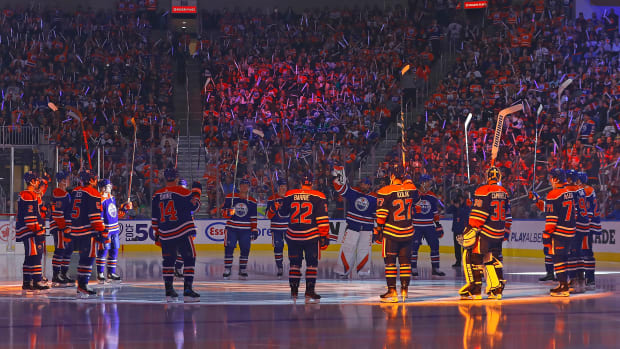The ways we watch and listen to hockey content are constantly evolving, with new ways to consume games and additional data being added to on air broadcasts.
Teams and leagues are taking the next step to put even more content on their in-house streaming services or digital networks.
In some instances, they’re ensuring a team broadcast survives at all.
In the case of the Edmonton Oilers this past week, they launched their platform known as Oilers+, a year-round streaming service with great ideas behind it that has raised a few eyebrows around the hockey world.
The paid service provides fans with unique features, original programs, pre, and post-game coverage, and practice content.
“We believe there’s an audience out there,” said Stew MacDonald, the CEO of Oilers Entertainment Group. “Our fans have told us there’s an audience out there that says were ready to embrace and subscribe to this.”
There’s a lot on the service, and there’s quite a bit of behind-the-scenes content that also features players and staff away from the rink. In an era where peeling the layers back on athletes is as big as ever, various shows on the app, from The Drop to Two Days In Toronto, do an excellent job of showcasing different Oiler personalities.
MacDonald said that content from the Oilers website and other platforms won’t be leaving but that the app will expand on what they already do.
“What we’ve had previously free is staying free, so our website, our mobile app, our social platforms, our goal isn’t to pull content from there,” MacDonald said. “We’re going to duplicate some of it on Oilers+, but we’ll be maintaining and expanding the content as we always do on those free platforms. This one just gives us with the overhead that’s connected to it, going deeper and expanding staff.”
A cool idea, but some Oilers fans are turned off from the $8.99 monthly fee or $59.99 annual fee – granted, there’s a three-day free trial along with promotions in the service.
While yes, press conferences and pre-game content is still available on the Oilers website and other platforms, those examples of content are no longer streaming live on YouTube and Twitter. It’s hard to miss the comments on the Oilers YouTube page asking for the live content to return to YouTube.
But the Oilers are not the first to charge for the ability to watch pre- and post-game content live.
Leafs TV, the innovative channel launched by MLSE, was one of the first outlets to air press conferences and exclusive Toronto Maple Leafs and Marlies content in their entirety. But it wasn’t free, as cited by Adam Seaborn, a sports media analyst and the head of Partnerships at Playmaker Capital.
“Remember, that was a paid service – you had to pay a monthly subscription on your cable package to get Leafs TV,” Seaborn said. “The fact that they were free for a long time on YouTube was a pretty recent innovation. It hasn’t been that long that we’ve been able to get every single press conference for free – I think now, with the economics of the cable bundle and the economics of the television networks, it makes sense for that to go back behind a paywall to some extent.”
It will be interesting to see the numbers of how many fans go for it if those become public. Can you truly put the genie back in the bottle after these many years of free content for the fans in the modern era of digital sports content?
On the flip side of streaming, it has ensured you’re not entirely left in the dark regarding live game coverage for some teams. A team like the Edmonton Oilers will never have to worry about losing platforms to air their games or other content on, but in smaller markets and in different leagues, that is not always the case.
With their games not on a traditional radio station this season, the AHL’s Belleville Senators recently launched the Belleville Sens Entertainment Network.
The platform airing on digital platform Mixlr will air audio broadcasts of every game, interview, and other in-season content. Much like the Oilers, the network gives the Baby Sens the ability to control content but also ensures that fans can still keep up with the team if they don’t watch the games on AHL.tv – another instance of aggregating the broadcasts with an exclusive in-house streaming service.
With the number of local radio and television platforms and sports departments collapsing in various markets, it wouldn’t be surprising to see more teams take this approach to content distribution outside of the NHL.
As the streaming game evolves more and more, teams will try to see how it will benefit them and their audiences as the question of “what’s next” continues to change in content consumption.



